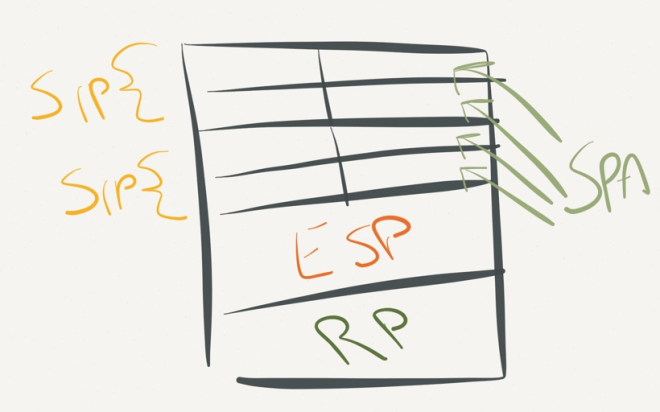The ASR 1000 is based on four main components: ESP (Embedded Services Processor), RP (Routing Processor), SIP (SPA Interface Processor) and SPA (Shared Port Adapter).

Each component has a varying level of intelligence when it comes to packet processing and QoS.
SPA
The simplest piece, the SPA, merely provides interface connectivity. It’s a small, usually white card, about 1/2 the width of the linecard it sits in.

5-port Ethernet SPA module from Cisco.
SPAs come in both half-height versions (like the image above) and double-height varieties. Double height SPAs are the same width but occupy the bottom and top SPA ports of one-half of the SIP
SIP
Next is the SIP. It looks like a line card with empty slots and holds the SPAs. The SIP is smarter than a SPA, but is not responsible for any forwarding. It does some buffering and QoS work, but not much else. Each SIP connects through the backplane to the ESP. Both the SIP10 and SIP40 support 4x 10Gig SPAs. The difference between them is the SIP10 only has a single 11.5Gbps connection through the backplane. The SIP40 has two 23Gbps connections providing 46Gbps of throughput, so 4x 10Gig SPAs can be supported without oversubscribing the module.

ASR 1000 SIP Module from Cisco.
ESP
When it comes to packet forwarding the ESP does all the real work. The ESP rating is stating the throughput of that ESP. ESP-10 supports 10 Gbps, while an ESP-40 provides 40 Gbps, across the chassis. The ESP performs all routing lookups, QoS and any features like Zone-based firewall or GRE. A special processor created by Cisco, called the QFP, powers the ESP. You can think of the QFP like a video card’s GPU. It’s more flexible than an ASIC, but not as flexible as a normal desktop (x86) CPU. It’s good at a few tasks related to moving packets, but can’t handle things like running DUAL for EIGRP best path calculation.

ASR 1000 ESP-100 and ESP-200 Modules from Cisco.
In my previous post about TCAM I mentioned that the ASR1000 has more dynamic memory to store the forwarding table (show ip cef). This memory lives directly on the QFP, on the ESP.
Two important notes: First, this rating is for unencrypted traffic. If you are planning to pass encrypted traffic double check the data sheet. Second, pay attention to the slot and ESP connections. For example, on the ASR1013, an ESP-40 only provides a single 23 Gbps connection to slots 4 and 5. The ESP-100 provides two 23 Gbps connections to all 5 slots. The ASR1006 does not have this gotcha.
RP
Outside of the data plane lives the RP. The RP holds a general purpose CPU that’s responsible for the control plane. This CPU will manage all the routing protocols and will tell the ESP routing information. The RP will also have its own memory, but this memory is different than what is on the QFP. The RP memory is for the routing table (show ip route), OSPF database, IOS and other processes and data structures.
The RP currently comes in two flavors, the RP1 and RP2. RP1 is a 32-bit 1.5Ghz processor. The RP2 is a 64-bit 2.66Ghz processor. This allows the RP2 to support more memory, but there is a catch related to how IOS works on the ASR1000 and it’s ability to address more than 4Gb of RAM (a topic for a future post).
An easy way to tell the RP apart from the ESP is that the ESP never has ports, while the RP will contain the console, AUX and management ethernet ports.
How Do I Choose?
SPA: Pick the ports you need today and in the future.
SIP: Remember that the number indicates the total throughput of that module. SIP10 can hold 40 Gbps of ports, but can only pass 10 Gbps of traffic.
ESP: Again, throughput. Just like the SIP, consider what growth looks like in the future and what you need today. On the ASR 1013 you may need to go for an ESP-100 if you need greater than 20 Gbps out of slots 4 and 5.
RP: The driver for RP1 vs. RP2 will be how many routing peers you will have and how many routing update will occur. An internet edge device with multiple providers will see more updates than a datacenter interconnect router. Most mid to large-scale DMVPN deployments see a lot of benefit with RP2 over RP1. If you don’t have many peers, but need lots of bandwidth consider an RP1 combined with a faster ESP.
For more information on the ASR1000 architecture take a look at the Cisco Live presentation about the platform by Steven Wood, Cisco Technical Marketing Engineer.

Reblogged this on Dirigeant.societe.com.
LikeLike
Very Interesting .I like it.
LikeLike
This is a great intro to ASRs and very handy for anyone familiar with Cisco ISR routers to point out the differences. Thanks
LikeLike
this is great info …
I need more information about asr1000 series router
que1 => how packet flowing inside router i means how goes in and out
que2 => How to determine which RP(route processar)will become active and which RP acts as a standby while router booting up
same for ESP also
it would be great help if you can answer
LikeLike